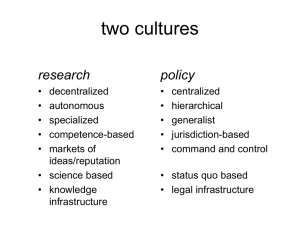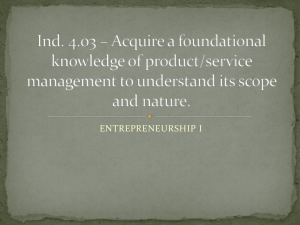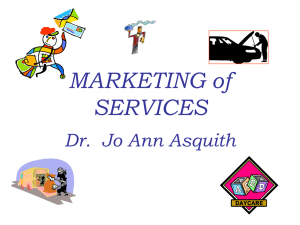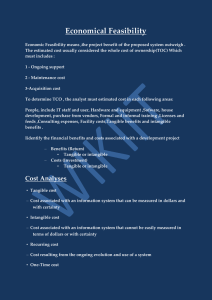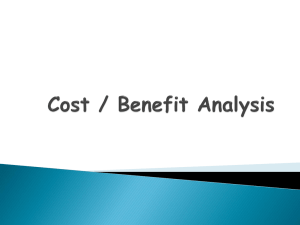Cost-Benefit Analysis
advertisement
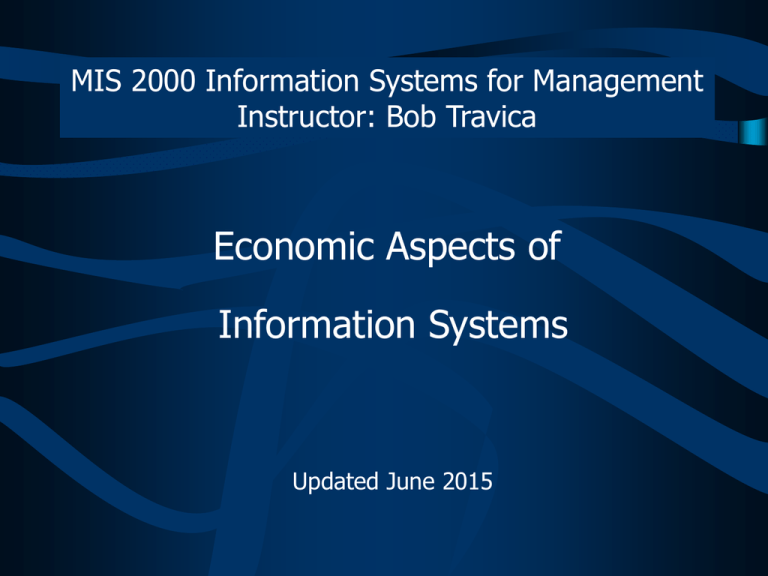
MIS 2000 Information Systems for Management Instructor: Bob Travica Economic Aspects of Information Systems Updated June 2015 Outline • Costs & Benefits from IS • Financial Assessments of Information Systems Economy (size and timing of returns) • Combined Assessments of Information Systems Economy • Software & Hardware Acquisition (develop, buy, rent) • Summary 2 of 14 Costs & Benefits from IS • Economic aspects of IS (or IS economy) is assessed in planning of IS as well during IS production stage. • Cost/Benefit analysis is a necessary component in any assessment of IS economy. Cost-Benefit Analysis • Tangible Costs & Benefits ($) • Intangible Costs & Benefits (no $) Quantitative or qualitative figures? Quantitative Capital Budgeting Methods ($) • Assessments of returns’ size • Assessments of returns’ timing Qualitative & Quantitative Mixed Methods ($ and no $) • Portfolio Analysis (Risk control) • Balanced Scorecard (Org. goals achievement) 3 of 14 Tangible Costs - Direct investment in software & hardware (one time) - IS installation & employee training (one time) - Operating costs for an IS (recurring) – expenditures on software licences, labor costs of IS staff, IS maintenance, overhead for facilities, expenses of communications carried out by computer networks partaking in IS. - Loss of money and time with new IS that does not perform as expected (opportunity cost). - Total Cost of Ownership sums up all the costs in a system life cycle. 4 of 14 Intangible Costs - Effort put in learning a new IS and associated process - Employees’ loss of work motivation due to new processes/IS - Employees’ resistance to new processes/IS - Lower customer satisfaction due to improperly performing IS - Limitations in decision making when a new IS cannot deliver reports managers need to make decisions. - Note that intangible costs may result in tangible costs. 5 of 14 Tangible Benefits 1/2 - Savings on many counts: - savings on labor expenses - savings due to reduced process time (e.g., reducing inventory costs in supply chain process) - savings due to avoiding to add more employees when improved process/IS can carry a larger volume of operations - Organizational performance gains: new IS & process organizational productivity (output value/input cost) financial returns (profit figures). 6 of 14 Tangible Benefits 2/2 - Better decision making resulting in income increase (e.g., moving into new product and geographical markets) - Cutting losses by improved management control (e.g., ERPS case of detecting fraudulent purchases) - Data error reduction eliminating waste of business time & labour for repeated tasks. 7 of 14 Intangible Benefits - Customer value that does not translate directly into monetary gains for a company - Better control and decision making, which do not translate readily into monetary gains - Improvement in the appearance of reports and other business documentation (better quality but no more money). - Increased knowledge capabilities (note: these are a condition for making more attractive products, but before this products are made and sold no monetary gains accrue). 8 of 14 Financial Assessments of IS Economy • 1. Returns’ size focus: Various ratios of how much an IS returns in relation to its costs (Benefit/Cost Ratio, Net Present Value, Return on Investment): – The higher the ratios, the more economically valuable the IS – Present value of money used (future returns as well as costs discounted for some rate) as finances flow over years (NPV function in Excel) • 2. Returns’ timing focus: Assessment of when returns will occur (e.g., Break-Even Analysis) - The shorter the wait period, the more economically valuable the IS. 0 1 2 3 4 Time (years) 9 of 14 Mixed Methods of Assessing IS Economy 1/2 1. Portfolio Analysis – The focus is on controlling risks that different systems can bring – Risks: potential known difficulties (complications, problems) – In planning IS, different IS projects compared on risks they bear (e.g., completion within budget & time, technology demands, size of organizational change required) – Risk = Weight (impact) of problem X Probability a problem will happen – Risk can be thought of as a special and critical cost – Riskier projects: Expensive systems*, new technologies, and larger org. changes (e.g., enterprise systems) 10 of 14 Mixed Methods of Assessing IS Economy 2/2 2. Balanced Scorecard – The focus is on achieving organizational goals – A combination of tangible and intangible benefits in select areas – finances, customer relations, key processes, growth potential, anything else important for a company. – IS contribution to these performance indicators is assessed periodically. Balanced Scorecard Tangibles Tangibles & Intangibles - Process focus! Intangibles 11 of 14 Software and Hardware Acquisition • Three options: Make, Buy, Rent 1. In-house Development (company's IS Department does programming, hardware acquisition, and IS installation) 2. Buy: – Off-the-shelf software (e.g., Microsoft Office, SAP) – Buy custom-built software (a software vendor writes software according to the client company’s requirements). – Note: If there is a system development capability in the IS Department, the buy options are called “outsourcing” (sourcing outside of own company) • For pros & cons (benefits & costs) see the chapter. More… 12 of 14 • 3. Rent: – Annual licencing of software or hardware – Rent via the Cloud (partial or total IS services). • Cloud Advantages: – Reduce costs: pay-per-use, avoiding development & maintenance costs – Client benefits from new IT as vendor keeps updating it to remain competitive gains in client’s business processes. • Cloud Disadvantages: – Synchronizing business processes between client and vendor – Risk of compromising confidentiality of business data – Vendor lock-in (it is hard to get out of Cloud as a company relies more on a cloud vendor) – Unexpected changes in pricing services. 13 of 14 Summary • Costs of IS can be tangible (expressed in monetary terms) & intangible (all other forms). Examples of tangible costs are investment in computer software and hardware, and system’s operating costs. • Benefits of Information Systems can be tangible & intangible. Examples of tangible benefits are cost reduction and income gains. • Financial Assessments of IS economy focus on the size of returns (e.g., NPV) and on timing of returns (e.g., payback period). • Mixed Assessments of IS economy cover tangible and intangible C/B (portfolio analysis, and balanced scorecard). • Software can be developed by the company’s IS department, purchased, or rented; hardware is usually purchased or rented. Each option has pros and cons. • Cloud (cloud computing) is the trendy rental option with significant pros & cons. 14 of 14

